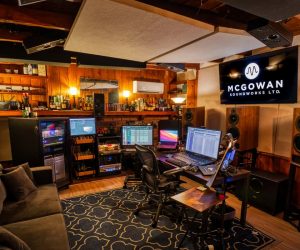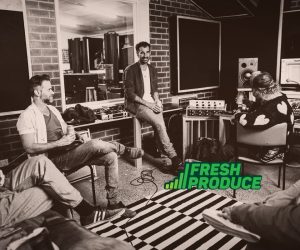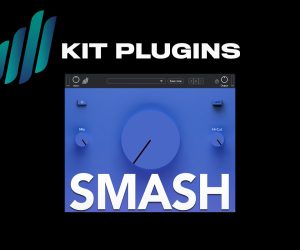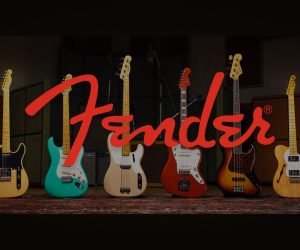
Grand Final Day at the MCG
Crowds don’t come much bigger or noisier than the one that gathers at the MCG on AFL Grand Final Day.
The AFL Grand Final is most likely a distant memory to all but Cat and Hawk fans by now. For those who didn’t see the game back in late September because they either A: couldn’t care less about sport in general or B: couldn’t care less about Australian Rules specifically, let me briefly recap. Geelong lost to Hawthorn in arguably one of the greatest upsets since 1991 when Angry Anderson and Robert De Castella rode around Waverley Park in a Batmobile/P76 hybrid, looking like forgotten members of the Village People.
The AFL Grand Final – which, for the benefit of any Martians amongst the AT readership, is held at the MCG – was this year attended by 100,012 people. Of course, given the result, by the final siren there must have been at least a few Cats supporters heading for the train, but by then the PA which powered the pre-match entertainment was already tucked up in bed down at Norwest Productions’ Moorabbin warehouse. The PA left the arena so fast you could have mistaken it for Elvis.
SONIC BOOM
It’s difficult to describe the noise levels at the MCG on Grand Final Day. It’s like being repeatedly exposed to the noise of an F/A18 fighter taking off for the duration of the match… sometimes it’s like several taking off, with at least one or two jets firing their weapons at the same time. It’s completely insane. With the crowd repeatedly peaking at well in excess of 105dB (in my own estimation), it’s no wonder they call it a battle for the premiership… it’s a battle just to hear the person next to you.
Thankfully, the PA doesn’t go head to head with this noise floor/ceiling on the day. If it did it would surely lose. Filling this colossal stadium with clear and punchy audio seems like a challenge at the best of times; fighting the sound of 100,000 nutso footy fans screaming, jeering and cheering in mass hysteria would be harder than running backwards up an escalator balancing the PA in one hand.
The pre-match entertainment at the MCG this year was admirably led by Powderfinger in what must surely be one of the hardest and most daunting gigs a band can face: 100,000 people, all of whom are at least 70 metres from the stage. It’s a surreal experience for band and audience alike. The size of the arena dwarfs everything and any personal contact between band and audience is lost over an expanse of turf, making it exceedingly difficult to raise the show to any great heights.
Driving the live on-stage sound all the way up to the nose bleed seats was a task that Norwest’s capable team had confronted the year before. But unlike Geelong, Norwest used their previous Grand Final experience to advantage and the sound went off without a hitch. Norwest’s Andrew Marsh was part of the crack team in charge of making sure the MCG seamlessly transformed from an acoustic wasteland into a credible rock venue, then back into a sporting arena and finally a medal presentation arena. He had this to say when I caught up with him before the opening bounce.
PRE-MATCH WARMUP
Andy Stewart: Andrew, can I start by asking you how you see Grand Final day unfolding?
Andrew Marsh: It’s pretty straightforward, it mainly involves lots and lots of checks. We’re really diligent on testing everything, having multiple spares, spare lines on everything, that sort of thing. For example, Peter Lumley, who’s looking after the in-ears and radios will be checking back to our control room a bunch of times. We’re just carefully going through those motions at the moment. Spike [Greg Millikan] is looking after the Army guys who traditionally help out on the ground during the pre-match setup. He’ll be making sure they know how to transport the PA carts out onto the arena. I don’t know if it’s a sergeant or something, but they’ve also assigned Spike a guy to yell at them!
There are 54 Army personnel assigned to us: three per cart and a couple to pull out the multicore. Chris Leary, Jackson Ackers and Pat Kearney will be underneath the rollout stage and wiring up wedges, multicore and any microphone or ears placements out at centre stage. There are also another 25 sets of ears for the other performers involved in the event. Once the anthem is done, and our carts are coming off the ground, we hand the system over to the scoreboard control room. They’ll then turn on all the other boxes (House PA) in the stadium and we’ll just be running the control and microphones for the rest of the day.
Once the game starts, all those trolleys go straight into two eight-ton trucks, which ferry the PA straight back to the warehouse, where it’s unloaded. The trucks then turn right around and do another trip. So half of our equipment is bumped out by the time the game is finished.

All you can do is push a wide mono signal straight into the crowd and hope they absorb it.

GOING BACK TO BACK
AS: How is the PA setup different to last year’s production?
AM: It’s a little different to the way we did it last year. We’re still running optical, but not as a separate system. It’s run as part of the D5T Optocore system. Basically there are 18 speaker trolleys, each carrying three L-Acoustics Kudo three-way enclosures and an EAW SB1000 sub. We split the field up into two halves. At the player’s bench there are racks that drive nine carts, while at the umpire’s race on one side of the field, there are identical racks driving the other nine carts. The two systems are identical.
The subs are driven by Lab.Gruppen FP6400 two-channel amps, and the Kudo are driven by the new Lab.Gruppen 10000Q, which is the flagship four-channel model of the FP+ Series. The whole system is processed using Dolby Lake Processors.
The carts that the PA rides around on have been especially made up to carry an SB1000 and a bunch of Kudos, with self-tracking steering that enables you to hook them up and tow them with a buggy. The idea is that, if you go around a pot hole, the entire train of speakers will turn around it to. They’re pretty fancy.
AS: And apart from the PA enclosures, the system’s on the ground all day?
AM: Yep, the only thing that’s coming on and off are the actual enclosures themselves and the centre-stage equipment. There are copper feeds going around the boundary, to make up the power, and signal going from the Dolby Lake Processors is providing an analogue signal to the amps. That signal is split and line driven by XTA DS800s, which drive all the boundary feeds.
AS: What’s the longest cable run to a set of speakers?
AM: From memory it’s about 150m.
AS: Down copper. So it’s quite a push.
AM: Yeah, it is a push. But power is run using a Socapex [which is a multicore for power]. This breaks out into 6 x 16A ‘C-form’ connectors and feeds the carts from there. For the audio signal, we have long 12-way XLR looms that break down to four-way looms that feed the carts. All the connectors are colour-coded sitting at the boundary. A 15m loom with power and signal sits on the cart and the army guys pull this off and plug in the C-form and four XLRs waiting for them at that location on the boundary. We’ve got our guys running around making sure it’s done correctly and everything’s fired up. And that’s it. Tom Oliver is the man responsible for all boundary cabling and overseeing the setup on the field.
AS: Is there a reason why there’s not a digital feed all the way to the speakers?
AM: Yeah, it would mean a processor at every speaker cart, which is not economical.
NOT QUITE STEREO
AS: Is the signal that you’re driving into the stands mono or stereo?
AM: The speaker trolleys are broken up into left and right, so it goes left, right, left, right the whole way around the ground. So technically, when you’re in the stand you might be facing a left/right or right/left combination. The subs are mono, driven off an auxiliary send in the control room, but the main signal isn’t coming out of the console hard left and right; the matrix is set up so that wherever you are in the crowd, you’re always getting a little bit of the other side. In that sense it’s not a true stereo setup, it’s somewhere between wide mono and narrow stereo. That’s what we’ve found sounds best at the MCG.
AS: Is this approach based on the experience of setting up the PA this week, or from years of experience with various rigs?
AM: That’s from experience, mainly of setting up typical four-hang PAs in venues. I often cross the outside hang so the ‘outside-left’ hang is actually a ‘right’. That way, when an engineer pans something hard right, the audience covered by that section of the PA isn’t just hearing one side of the stereo signal and potentially missing half the content.
AS: Last time I was at the MCG, my impression was that it had become one of the largest echo chambers in the world. How do you deal with that?
AM: It’s not a good sounding place, that’s true. It’s really hard to deal with. Essentially all you can do is push a wide mono signal straight into the crowd and hope they absorb it. They’re essentially doing the work for you.


FIRING RANGE
AS: How are the Kudo speakers on the trolleys vertically aligned?
AM: They’re given a 10-degree angle off the speaker trolley, so the first box just gets over the boundary fence to do the first level and they rake up from there. The coverage is great, even up in the nose-bleed seats. The only part of the house system I’ve still got turned on is the very upper ring of rear-firing speakers that go back into the seats, and that’s just to get a little bit more top-end to the back of the uppermost decks. Up there you tend to lose the high-end signal simply due to the distance of the throw. So, we’ve just got them augmenting the top-end.
AS: So there’s no distinction then between what each of the three Kudos are reproducing? They’re not EQ’d differently to cater to the distances they’re trying to traverse?
AM: No. It would be nice to do that, but ultimately you’d need three times as many amps and processors.
PATCHWORK QUILT
AS: How does the audio for this massive event travel around the stadium?
AM: The audio initially travels optically down from the control room in the stand to the first boundary position, and then optically around the field to the second boundary position. The signals are all digital in and out, apart from the feed into the carts and the multicore run to the centre of the stage; they’re all copper.
AS: What mixing consoles are you using and what tasks are they performing over the course of the day?
AM: There’s a Digico D5T in the control room; we’ve cut out the Yamaha PM5D for monitors, and Grant ‘Tosh’ Walsh and Ernie Rose are both on the D5T. Ernie’s doing the house mix, and Tosh is doing the monitor mix for everyone but Powderfinger. For Powderfinger, we’ve got a split under the stage going to a Crest console where Mark Crawley from Johnston Audio is mixing the band. But everyone else’s in-ears are done from the D5T.
AS: What’s on the stage for the band in terms of gear?
AM: Foldback is taken care of by Nexo PS15s, and apart from that it’s a pretty standard band setup. Powderfinger are playing 100% live, which is pretty unusual given the nature of the venue, and the gig. We’re all pleasantly surprised how good it’s been sounding at rehearsal, so fingers crossed it will sound great pre-match. What’s really surprising to me is that they’re not using in-ear monitors. Everyone else is though. We’ve got Sennheiser G2 in-ear monitors, Shure PSM700s, and hard-wired 600s. There are heaps of in-ears out there. Ian Moss is playing, as well as the two anthem singers from Wicked. There are also six girls on top of the scoreboard roof, singing with Shure PSM200s – hard wired.
PLAN B
AS: Is there a ‘redundant’ console in case things go pear-shaped?
AM: No. There’s just a redundant feature in the processors, which is basically another console without the work surface. It’s just got a screen, and a mouse, and that mirrors everything the Digico D5T does. Ernie’s got a Fairlight which is backed up by a Tascam DA88, both running timecode from the truck. Touch wood that doesn’t fail again this year – last year the broadcaster lost timecode and the playback stopped.


The crowd is well over 100dB. I’d guess it’s up to 110dB with the crowd really peaking!
BALLPARK FIGURE
AS: Is there a restriction on the PA’s volume pre-match, or can you crank it as much as you need to?
AM: There’s no set volume, it’s pretty much just a case of pushing it to get up over the crowd. It’s so noisy in there! We’ve been given no restriction by the AFL, not even a ballpark figure. The crowd is well over 100dB. I’d guess it’s up to 110dB with the crowd really peaking!
AS: Post match entertainment is all house PA then, is it?
AM: House PA, yes, but with our microphones, cables and control. We just send the signal back to them via the shortest distance possible: out of a Digirack on their side, into a house patch and straight up to their control room. I’ve chosen the shortest internal house patch that I can to get back to their control room, because some of it’s very noisy.
AS: Have the rehearsals left you feeling quietly confident or are things still feeling a little unpredictable?
AM: Well, actually, I went to the rehearsal yesterday, and things were still a little up in the air. For instance, when people started plugging carts in, the MCG’s 100A three-phase wiring that we use just dropped dead. The Residual Current Device (RCD) on the system tripped; we’re only using a 63A three-phase distro on that side of the field. This tells me that there’s something very sensitive about the MCG’s supply. The same thing happened last year: long cable runs, a voltage drop, a bit of imbalance between the phases, and it just freaks out. I had to ring the house electrician and say, ‘take us off RCD’, we’ve got our own here. Power’s definitely a problem. If you don’t get it right and balance the phases, or if you’ve got too many RCDs in line, you can easily find yourself in trouble.
AS: How do you balance the phases?
AM: You just try and balance the load, balance how much current draw there is on each phase. If you load up one side too much, not only are you going to eventually reach the limit, the RCDs are going to get a bit ‘funny’ especially since they’re three-phase devices – they feel one side going… and boom. And if everyone turns on the amplifiers at the same time, and the amps simultaneously take an inrush of power, the breakers are just going to freak out and shut down.
AS: Is there a choreographed or staggered approach then to powering up the PA?
AM: There is now! The control stays on, there’s a three-phase feed that runs up to our control room, and it’s a throughput of our master distro on that side of the field. On both sides of the field, our 16A feeds get turned on individually, one by one.
AS: In the past they’ve been plugging into an amp that’s already on, is that what you’re saying?
AM: Yep.
AS: I thought that would have been potential for disaster. Don’t the amps have switches?
AM: Yeah, but we don’t want the army guys touching the amps, so it’s them getting the power in and us turning the breakers on from the boundary feed. We found that’s the best way of doing it.
AFTER THE FINAL SIREN
If post-match celebrations are any indicator, the Grand Final was a roaring success from an audio point of view. Everything performed as planned and even the national anthem played on time and on cue… everyone was holding their breath half expecting an AC/DC, Hunters & Collectors medley to leap from the PA… but it wasn’t to be.
As for the football, well, that’s another story…
















RESPONSES